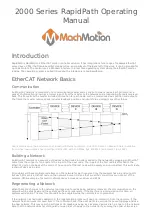
MDX [en-US]
27
Operating Conditions of Flow and Head
It should be noted that the pump always operates at the intersection of the pump curve and the pipeline "system" curve.
During the initial stages of operation, motor load on the pump should be checked. If there is an excess amount of power
being drawn by the pump, it may be caused by the system head (TDH) being lower than predicted thus resulting in
higher flow rates and power consumption. This sometimes happens when a safety factor is applied to the head during
the design of the system. Cavitation may also occur under these high flow conditions. The pump speed should be
slowed down to reduce flow, or the total discharge head against the pump should be increased (resulting in reduced
flow and power consumption).
If actual supply flow rates are lower than predicted, the sump may run dry causing the system to surge and accelerating
pump wear. Pump speed or impeller diameter should be decreased or make up water increased to keep the sump at
the highest stable level possible. If the flow variations are too great, a variable speed motor may be required. This
problem is especially common in applications with a high proportion of static head, such as mill discharge and cyclone
feed. It can be further aggravated by operation well below the best efficiency flow rate of the pump where the pump
head curve is relatively flat. Under these conditions, minor fluctuations in the system resistance caused by normal
variations in solids concentration or size can result in surging flow rates.
Whenever possible, avoid prolonged operation at flows well below the optimum flow rate. This causes recirculation of
slurry within the pump and encourages localized wear.
In the event problems are encountered, contact your GIW / KSB representative. The pump serial number, in addition
to the following, should be furnished to assist in evaluation of the problem:
o
Pump serial number (from the nameplate on the pedestal or bearing housing), customer location, and the
approximate startup date.
o
Pumped fluid SG (specific gravity), slurry information including SG and particle size, and liquid temperature.
o
The approximate flow rate desired and the actual minimum and maximum flow rate of the system if known.
o
The system static head (the difference in elevation between the water level on the suction side of the pump
and the point of discharge)
o
The length and size of suction and discharge lines, including a description of the general arrangement
including fittings, bends and valves
o
If the discharge point is not to atmosphere, what is the pressure, (e.g. cyclone backpressure).
o
If suction is taken from a sump, provide the general arrangement including size dimensions and minimum and
maximum sump levels referenced to the suction centerline of the pump.
o
The available driver horsepower, speed of motor and pump or description of the ratio device between the
pump and motor.
o
The impeller diameter if different from that supplied with the pump.
The above items of data are especially important when a pump has been transferred from the duty for which it was
selected to some other application.
In many instances, it will be found that unusual wear in the pump, or low efficiencies, are caused by a mismatch between
the pump and the system application and can be corrected once the operating conditions are known.
Contact your GIW / KSB representative for further specific recommendations regarding system design. A useful
reference and textbook has also been published by GIW titled: "Slurry Transport Using Centrifugal Pumps", by Wilson,
Addie & Clift.
Summary of Contents for GIW MDX
Page 53: ...MDX en US 53 14 Notes...
















































